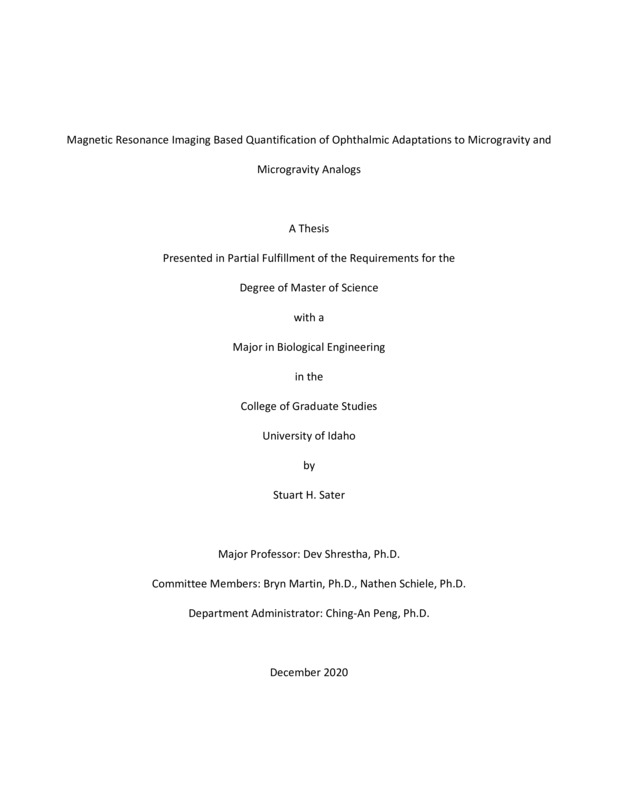Magnetic Resonance Imaging Based Quantification of Ophthalmic Adaptations to Microgravity and Microgravity Analogs
Sater, Stuart. (2020-12). Magnetic Resonance Imaging Based Quantification of Ophthalmic Adaptations to Microgravity and Microgravity Analogs. Theses and Dissertations Collection, University of Idaho Library Digital Collections. https://www.lib.uidaho.edu/digital/etd/items/sater_idaho_0089n_11970.html
- Title:
- Magnetic Resonance Imaging Based Quantification of Ophthalmic Adaptations to Microgravity and Microgravity Analogs
- Author:
- Sater, Stuart
- ORCID:
- https://orcid.org/0000-0002-7434-0900
- Date:
- 2020-12
- Program:
- Biological & Agricultural Engineering
- Subject Category:
- Biomedical engineering
- Abstract:
-
Spaceflight has long been known to have adverse effects on the human body. Many spaceflight-induced alterations such as bone and muscle atrophy are well understood and have mitigation strategies that have been successfully implemented. More recently, some astronauts have been presenting with a series of unusual physiologic and pathologic neuro-ophthalmic symptoms after long-duration spaceflight (> 6 months). These symptoms are collectively referred to as Spaceflight Associated Neuro-Ocular Syndrome (SANS), and include optic disc edema, posterior optic globe flattening, retinal and choroidal folds, cotton wool spots, and hyperopic refractive error shift. SANS is thought to be caused in part by mild but chronic elevation in intracranial pressure (ICP) caused by a headward fluid redistribution that occurs in space due to the lack of a gravitational vector. To simulate these headward fluid distributions, head-down tilt (HDT) studies have been implemented as a ground-based analog to spaceflight. HDT studies are advantageous in that they offer more opportunities to test mitigation techniques, more comprehensive imaging and monitoring, and allow for a larger number of study subjects in a shorter amount of time. The following studies provide automated and quantitative assessment of physiologic neuro-ophthalmic changes that occur due to spaceflight and HDT. Optic nerve (ON) and optic nerve sheath (ONS) cross sectional areas and ON deviation were assessed in healthy subjects during acute head-down tilt. While ON area did not change, both ONS area and ON deviation increased significantly. The posterior globes of long-duration spaceflight astronauts and HDT subjects were quantitatively assessed for globe flattening in the form of posterior volume displacement. Both cohorts reported significant volume displacement that in the case of astronauts did not resolve within a year after landing. Furthermore, centrifugation was tested as a mitigation technique for globe flattening in the HDT cohort and was not found to significantly reduce volume displacement. The quantitative methods described here will help in the understanding of SANS etiology and will inform future mitigation strategies.
- Description:
- masters, M.S., Biological & Agricultural Engineering -- University of Idaho - College of Graduate Studies, 2020-12
- Major Professor:
- Shrestha, Dev
- Committee:
- Martin, Bryn ; Schiele, Nathen
- Defense Date:
- 2020-12
- Identifier:
- Sater_idaho_0089N_11970
- Type:
- Text
- Format Original:
- Format:
- application/pdf
- Rights:
- In Copyright - Educational Use Permitted. For more information, please contact University of Idaho Library Special Collections and Archives Department at libspec@uidaho.edu.
- Standardized Rights:
- http://rightsstatements.org/vocab/InC-EDU/1.0/

